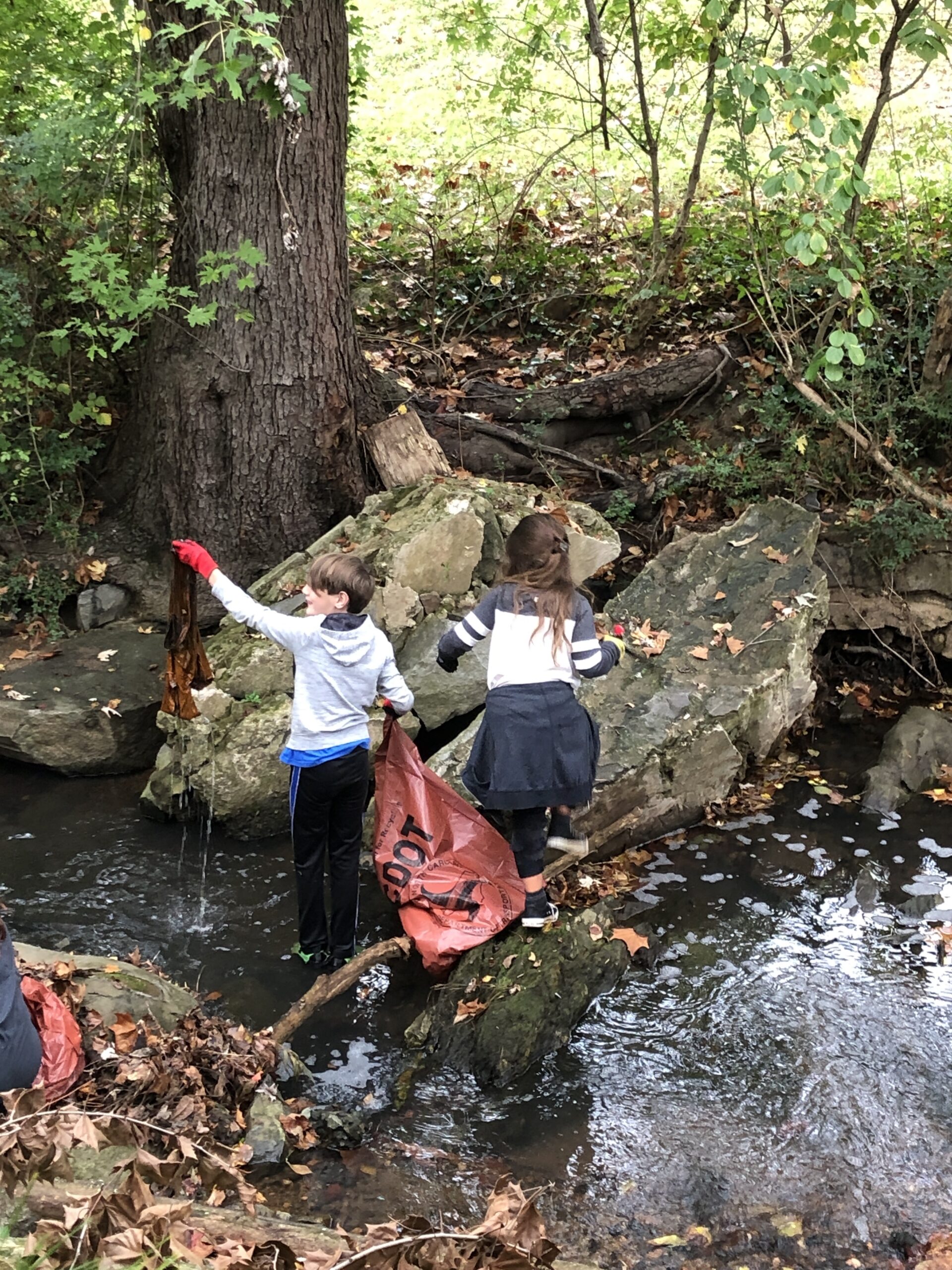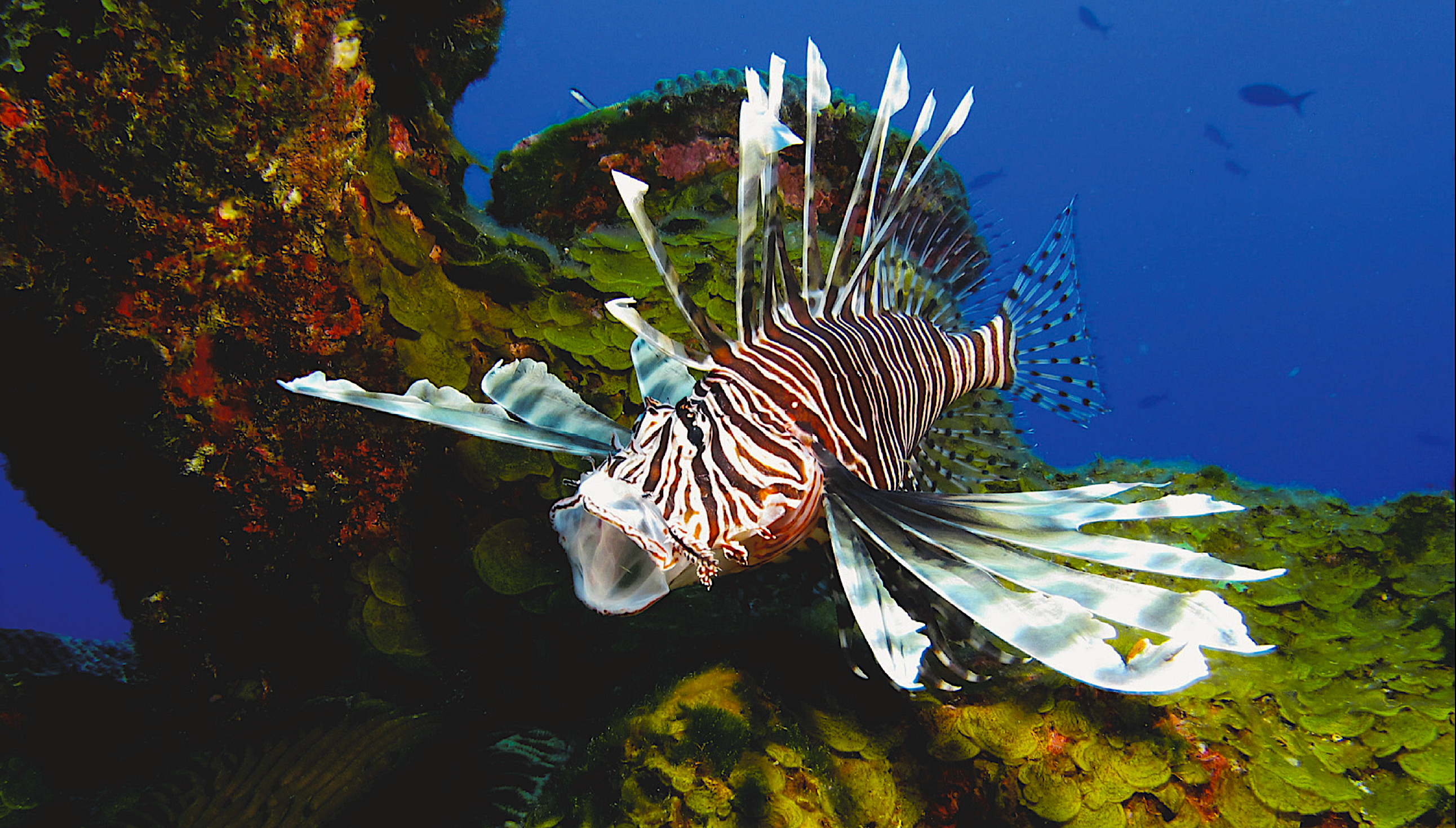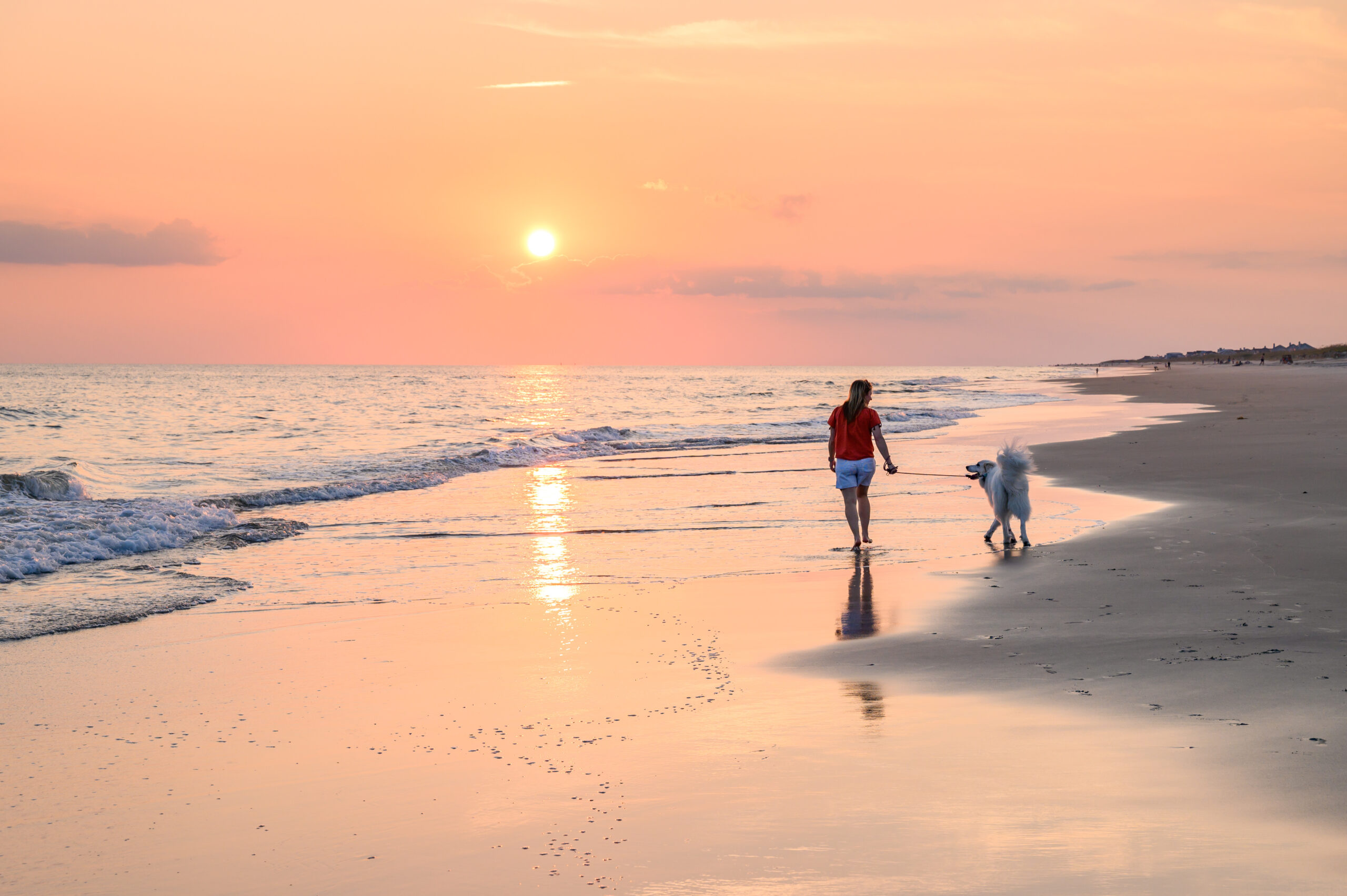Creating Clean Environments: Big Sweep Offers New Curriculum Guide

As Jennifer Dziedzic leads volunteers along the banks of the Rocky Branch stream at North Carolina State University, it doesn’t take long for her trash bag to fill up.
With plastic gloves covering both hands, Dziedzic bends over and picks up a pile of cigarette butts along the stream. “This must be a smoking spot,” says Dziedzic, a Cary High School science teacher.
Then she collects some tennis balls, a tobacco canister and plastic wrappers along a stream that has been restored in a decade-long multi-million dollar project headed by Barbara Doll of North Carolina Sea Grant.
On another part of the creek, a volunteer uses a long orange stick to scoop up a Styrofoam cup and soda bottle.
“I have traveled a lot and wanted to make a difference in my community,” explains Sonia Bruck of Cary High School.
At the fall cleanup, 17 volunteers, including Cary High School students, pick up 37 bags of trash estimated at more than 185 pounds. The litter includes a set of plates, coffee mugs, glass bottles, clothes and numerous other items.
“Cleaning up trash allows kids to get involved and opens their eyes to what people leave behind,” Dziedzic says. “I hope these students will influence their friends not to litter.
Statewide Cleanup
The Rocky Branch cleanup was part of the 2007 Big Sweep cleanup across the state. More than 18,000 volunteers retrieved more than 720,000 pounds of trash, 204 appliances and around 2,100 tires. All of the litter releases toxins in water or soil when disposed of improperly.
They also found 17 animal entanglements from — an octopus forgotten in a net to a raccoon in a discarded swingset. Only two animals could be released alive: a mallard duck found in fishing line in Guilford County and a snake caught in a bottle in Pamlico County.
Volunteers retrieved twice as many ensnarled animals as compared to the 2006 cleanup, says Judy Bolin, director of North Carolina Big Sweep. “People can be so careless and cause wildlife to suffer.”
A 2007 National Marine Debris Monitoring Program study found that marine debris not only kills turtles, fish, birds and other wildlife through ingestion and entanglement, but also is costly for coastal communities because of removal expenses, lost tourism revenues and reductions in property values.
“Trash in our oceans doesn’t fall from the sky, it falls from our hands, and it can be prevented,” says Laura Capps of the Ocean Conservancy that conducted the study with funding from the Environmental Protection Agency. “Simple steps like properly disposing of trash, reusing packaging and removing discarded fishing gear from the water makes a significant positive impact on the health of the ocean and its wildlife.”
To make middle school students more aware of keeping a clean environment, Big Sweep has produced Undercurrents: A Big Sweep Middle School Teacher’s Guide. Compiled by North Carolina Sea Grant and Big Sweep in partnership with GlaxoSmithKline, the publication includes 11 litter awareness lessons written by two North Carolina teachers.
The lessons correlate with the N.C. Department of Public Instruction’s goals and objectives for the sixth, seventh and eighth grades. The activities match various science, math, healthful living, language arts and information skills.
“Undercurrents lessons should provide teachers with many useful activities that can be shared with students,” Bolin says. “The guide also includes material on trashy toxins — released from some chemicals — as well as heavy metals and contaminated water, and soil disposed of improperly or dumped as litter.”
The publication features fun activities for children — from inventing a “Superhero” or “Superheroine” who can change people’s littering behavior to organizing a contest for slogans on trash cans in schools, homes and communities.
The cover features a colorful illustration by Linnea Lieth of McDougle Middle School in Chapel Hill. Other designs from middle school students open the front of each chapter.
Undercurrents is the third educational guide produced by Big Sweep and Sea Grant, including Splish Splash for grades K-3 and Ripples for grades 4 and 5.
“It’s been over 15 years since Splish Splash and Ripples were produced for K-5 teachers,” says Terri Kirby Hathaway, North Carolina Sea Grant marine education specialist and Big Sweep board member.
“With the new guide Undercurrents, not only are we reaching additional grade levels, but we are bringing litter and marine debris into the public eye once again.”
Worldwide Beach Sweeps
All over the globe, many organizations are involved in litter cleanup. The Ocean Conservancy holds an International Coastal Cleanup around the world — from Mexico to Shanghai. Each year, nearly half a million volunteers around the world spend a few hours removing trash and debris from beaches, lakes, rivers and other waterways and document their findings.
The National Oceanic and Atmospheric Administration’s (NOAA) Marine Debris Program focuses on identifying, reducing and preventing debris in coastal waters. One of NOAA’s most visible projects is the cleanup of debris along the Northwestern Hawaiian Islands (NWHI), home to endangered Hawaiian monk seals, green sea turtles, seabirds and a near-pristine coral reef ecosystem.
Due to the islands’ location in the North Pacific, these marine species and ecosystems are threatened by marine debris which accumulates there. Most of this debris consists of abandoned fishing gear, which can entangle and severely injure or even kill wildlife.
Since 1996, the NOAA Pacific Islands Fisheries Science Center’s Coral Reef Ecosystem Division staff has removed derelict nets from the reefs and shores of NWHI. To date, more than 628 tons of net have been recovered from this area.
In 2006, this removal effort switched to a “maintenance mode.” Smaller, more targeted removal efforts were conducted focusing on high-density areas of abandoned fishing gear. Today, nets brought back are used to create usable electricity in Hawaii’s trash-to-energy program.
The nets are transported to a scrap metal recycler. There, the nets are chopped into small pieces suitable for incineration at the City and County of Honolulu’s H-power waste-to-energy facility. There, the nets are burned, producing steam, which drives a turbine that creates electricity.
N. C. Efforts
North Carolina’s beach litter cleanup kicked off in 1987 when Lundie Spence, then a Carolina Sea Grant marine education specialist founded Beach Sweep. During the first year, the cleanup was confined to the coast, attracting more than 1,000 volunteers who collected more than 14 tons of debris.
After working with the Ocean Commission a coastal litter pickup in Texas, Spence decided to start a similar effort in North Carolina.
“I carried the torch back, and people n North Carolina built the bonfire,” says Spence, now director of the Center for Ocean Sciences Education Excellence-SouthEast in Charleston, S.C.
In 1989, the public-private partnership became Big Sweep, the nation’s first statewide water cleanup. Since then, almost 250,000 Big Sweep volunteers have participated in the massive statewide effort.
“It is important to clean up the beaches in Carteret County,” says Sarah Lavinder, Carteret County coordinator. “Our main economy is from tourism. If the beach is dirty, visitors don’t want to come back.”
Trash on the beach also is a threat to birds and other animals. Plastic waste kills many marine animals when they mistake it for food.
Big Sweep is involved in several stewardship projects. More than 10 years ago, Dee Dee Whitt started “Don’t Leave Your Butt on Beach or Golf Course.” As an R.J. Reynolds Tobacco Co. employee and Big Sweep board member, Whitt created eye-catching cards and bumper stickers about the improper disposal of cigarette butts. The program is still in demand.
The organization hopes to continue its educational efforts by providing pocket ashtrays and other materials as funding becomes available, Bolin adds.
Through Plus-One Boating, boat owners take their waste and one other piece of trash home with them. Although federal law prohibits disposal of plastic in waterways, the U.S. Coast Guard has difficulties enforcing the regulation.
Big Sweep also sponsors the Marina Monofilament Line Recycling Project, in which citizens make containers out of PVC pipes to recycle monofilament fishing lines found at piers and the marinas. Monofilament is a type of synthetic material that does not biodegrade.
All together, 91 inland and coastal marinas in 34 North Carolina counties are involved in the marina project.
To order Undercurrents, call 800/27sweep or download a copy at ncbigsweep. Learn about North Carolina Sea Grant.
OCTOBER BRINGS 2008 BIG SWEEP
Want to help clean up North Carolina’s rivers, lakes or coastal waters?
North Carolina Big Sweep needs volunteers from across the state to retrieve litter from the state’s waterways on Oct. 4.
Volunteers will gather trash from waters in all 100 North Carolina counties. Other cleanups include highways, schools grounds and parks.
Get volunteer registration and additional Big Sweep information online or call 800/27-SWEEP.
MARINE DEBRIS CLEANUP
For years, marine debris was considered a harmless eyesore. But recent research proves that debris has serious effects on the marine environment, wildlife, the economy, human health and safety, according to the National Oceanic and Atmospheric Administration (NOAA).
To combat the problems, NOAA’s Marine Debris Program has developed educational materials. The following are interesting facts about marine debris.
- The majority of marine debris comes from people’s mishandling of water materials while on land.
- A glass bottle takes one million years to break down in the environment.
- Every day, the average American discards 4.5 pounds of trash.
- Seabirds and other marine mammals are affected by ingestion of, and entanglement in, marine debris.
- An aluminum can takes 80 to 200 years to break down in the environment.
- Marine debris entanglement and ingestion has been reported among six out of seven sea turtle species worldwide.
- Debris can be blown into the water or carried by creeks, rivers, storm drains and sewers into the ocean.
- A plastic bag takes 10 to 20 years to degrade in the environment.
- It is illegal to dispose of any plastics in all U.S. waters and anywhere at sea.
- A cigarette filter takes one to five years to break down in the environment.
- In 2005, collisions with floating and submerged objects caused 269 boating accidents, resulting in 15 deaths, 116 injuries and $2.9 million in property damage.
- A newspaper takes six weeks to degrade in the environment.
Find out more about NOAA’s Marine Debris Program.
This article was published in the High Season 2008 issue of Coastwatch.
For contact information and reprint requests, visit ncseagrant.ncsu.edu/coastwatch/contact/.
- Categories:


